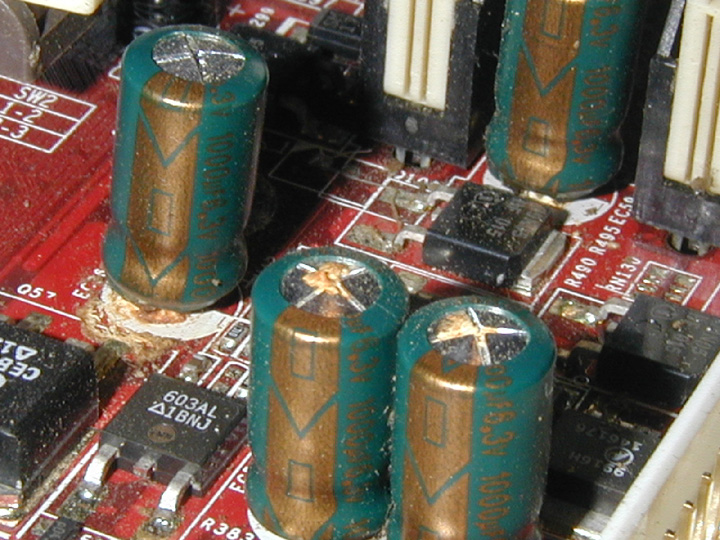
The early 2000s capacitor plague is probably not just a stolen recipe
arstechnica.com
Putting a cap on it The early 2000s capacitor plague is probably not just a stolen recipe Video takes a wider look at the busted caps of early 2000s PCs and other gear. Kevin Purdy Mar 20, 2025 2:04 pm | 14 An Athlon nForce motherboard with swollen, rusty, leaking capacitors, from what Ars forum member DaveB describes as "that time period." Credit: DaveB An Athlon nForce motherboard with swollen, rusty, leaking capacitors, from what Ars forum member DaveB describes as "that time period." Credit: DaveB Story textSizeSmallStandardLargeWidth *StandardWideLinksStandardOrange* Subscribers only Learn moreIt's a widely known problem with roots in urban legend: Devices with motherboards failing in the early 2000s with a sudden pop, a gruesome spill, or sometimes a burst of flames. And it was allegedly all due to one guy who didn't copy a stolen formula correctly.The "capacitor plague" of the early 2000s was real and fairly widespread among devices, even if the majority of those devices didn't go bad at the same time or even in the same year. The story of this widespread failure, passing between industry insider stories and media reports, had a specific culprit, but also a broad narrative about the shift from Japanese to Taiwanese manufacturers and about outsourcing generally.The Asianometry channel on YouTube recently dug into the "capacitor plague" in a video that asks, "What happened to the capacitors in 2002?" and comes to some informed, broad, and layered answers. It explains the specifics of what's happening inside both a working capacitor and the faulty models, relays the reporting on the companies blamed and affected, and, crucially, puts the plague in the wider context of hotter chips, complex supply chains, counterfeits, and, sure, some industrial sabotage."We will never know what exactly happened, but let's try," the host says at the start. It is recommended you follow along. "What Happened to the Capacitors in 2002?" by Asianometry. Without replicating too much of the video and larger mythos, the basic story is that, according to various disputed timelines, electrolytic capacitors put into electronics between 1999 and 2003 or so failed in dire ways from 2002 through (perhaps) 2007. Boards and computers bought from Abit, HP, IBM, and, infamously, Dell, among others, suffered these faulty capacitors and were handled with recalls, repairs, or, sometimes, silence.A finely balanced cocktailThe "Low equivalent series resistance," or "low impedance" aluminum capacitors at issue, contained an electrolyte solution that, when doing its job, served as a cathode and kept the paper separating two files inside the rolled-up capacitor saturated. Because the electrolyte is roughly 70 percent water, and the capacitor could take on wider fluctuations of voltage, it became a cheap, popular component in many devices.Much depends upon that electrolyte being the right mix of chemicals, making the formula a critical trade secret. The most popular theory of how the "plague" started is that one worker in Japan took an incomplete formula and brought it back to his former employer in China to utilize; then, a group from that Chinese firm propagated that formula into one or more Taiwanese start-up manufacturers. All of them were using electrolyte formulas missing crucial elements (namely depolarizers) that prevented chain reactions and gas build-up, leading to bulging, popping, leaking, and otherwise failing boards.That could have happened, and a decent amount of reporting at the time suggested so, though the number of first-hand sources narrows as you dig further. But the "single defector" theory is scrutinized in Asianometry's video.One guy or multiple forces?The problem was too widespread, among both devices and years, for isolated bad batches, Asianometry suggests. Many pegged the original Xbox's capacitor failings, sometimes after six or seven years, as part of the plague. This, despite most of the known "bad" capacitors of the time failing within 250 hours of operation. Also, the cited capacitors in the Xbox were made by Cooper Industries in Texas and also not actually aluminum electrolytic capacitors. These kinds of misplaced attributions tended to compound and spread further.During the same period, Asianometry notes, there was "a series of unconnected challenges faced by the capacitor industry as a whole." AMD and Intel (Pentium 4) began aggressively pushing single-core CPU speeds in the early 2000s, as Dennard scaling reached its end, adding lots of heat to already power-hungry devices. One thing electrolytic capacitors do not love is heat, and there was plenty of it before a broad move to multi-core around 2005 came into effect.What about the increasingly complex supply chain for electronics, involving international sourcing, multi-stage assembly, and potentially counterfeiting? Did the story of Chinese theft from a Japanese firm, then further exfiltration into Taiwan, have anything to do with broader anxieties about economic shifts? It's hard to rule those forces out.More on these matters is found in the full 22-minute video (which we first saw at Hackaday). It's both an eye-opening look at something some of us thought we knew and a relatively short journey back in time.Kevin PurdySenior Technology ReporterKevin PurdySenior Technology Reporter Kevin is a senior technology reporter at Ars Technica, covering open-source software, PC gaming, home automation, repairability, e-bikes, and tech history. He has previously worked at Lifehacker, Wirecutter, iFixit, and Carbon Switch. 14 Comments
0 Comments
·0 Shares
·80 Views


